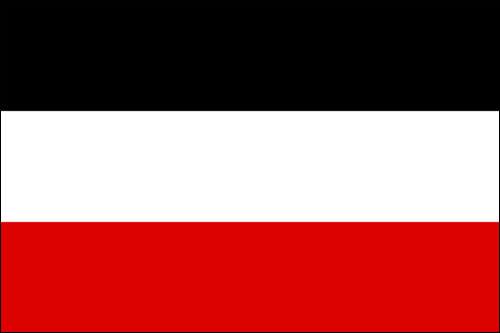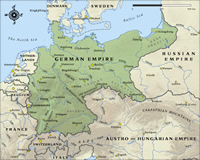Flag

1914 Map
Click on map for more detail
General facts
- Population: 67 million (1914)
- Capital: Berlin (1914 population 3.7 million)
Government
- Head of State:Kaiser Wilhelm II (15 June 1888 – 9 November 1918)
- Head of Government:
- Chancellor Theobald von Bethmann Hollveg (14 July 1909 – 13 July 1917)
- Chancellor Georg Michaelis (14 July – 1 November 1917)
- Chancellor Georg von Hertling (1 November 1917 – 30 September 1918)
- Chancellor Prince Maximilian von Baden (3 October – 9 November 1918)
The Kaiser agreed to abdicate after being told that he had lost the support of the German Army. On 10 November 1918 he crossed the border into The Netherlands, which had remained neutral throughout the war, and went into self-imposed exile.
Post-imperial Germany I: Interim period
- Friedrich Ebert (9 November 1918 – 11 February 1919)
Ebert headed the interim government but did not use the title of chancellor.
Post-imperial Germany II: The Weimar Republic
- Head of State: President Friedrich Ebert (11 February 1919 – 28 February 1925)
- Head of Government:
- Chancellor Philip Schiedemann (13 February – 20 June 1919)
- Chancellor Gustav Bauer (21 June 1919 – 26 March 1920)
In January 1919 a German National Assembly convened at the small town of Weimar to draft a constitution that would form the basis for a new democratic German republic in place of the discredited imperial model of government. As part of this process the assembly established the position of President of Germany on 11 February 1919 to replace that of the Kaiser as the official head of state. The constitution itself did not become law until August 1919, but the republic it helped to found would be forever known as the ‘Weimar Republic’.
The first ‘Weimar’ government was formed on 13 February 1919 under the chancellorship of Philip Scheidemann. Scheidemann resigned in protest at the harshness of the terms offered to Germany by the Allies in the Versailles Treaty, causing the first crisis in the Weimar Republic’s short history. The fact that his government did go on to accept the treaty ensured that this gesture was quickly forgotten. Over the next two decades the humiliation of ‘Versailles’ became inextricably associated with ‘Weimar’ politicians and government in the minds of many Germans.
Participation in the War
- Entered the war: 1 August 1914 (Germany declared war on Russia)
- Ceased hostilities: 11 November 1918 (armistice with the Allies)
- Ended belligerent status: 28 June 1919 (Treaty of Versailles signed with the Allies)
The Treaty of Versailles with the Allies was negotiated and signed by the first German government of the Weimar Republic, the successor state to Imperial Germany. The Weimar Republic inherited the obligations of and responsibility for the empire’s role as a belligerent in the war for the purposes of the Paris Peace Conference at Versailles.
Military Forces
Army
- Peacetime strength 1914: 840,000 Stehendes Heer (Standing Army)
- Reserves 1914: 3 million, including
- 1.3 million Reserve Army (aged 23–27)
- 1.7 million Landwehr (Territorials aged 28–38) and
- Landsturm (Home guard aged 17–20 and 39–45)
- Total mobilised 1914: 3.8 million
- Total mobilised during the war: 11 million
Navy
- Peacetime strength 1914: 72,000
Fleet (1914)
- Battleships (Dreadnoughts): 13
- Battleships (pre-Dreadnoughts): 30
- Battlecruisers: 6
- Cruisers: 14
- Light cruisers: 35
- Destroyers: 152
- Submarines: 30
Casualties
Military
- Dead (all causes): 2 million
- Wounded: 4.2 million
Sources
- Fritz Fischer, Germany’s Aims in the First World War, W.W. Norton & Coy, New York, 1967
- Hew Strachan, The First World War, Volume I: To Arms, Oxford University Press, Oxford, 2001
- Michael Stürmer, The German Empire 1871–1919, Weidenfeld & Nicolson, London, 2000
- Nigel Thomas, The German Army in World War I (1): 1914–15, Osprey, Oxford, 2003

